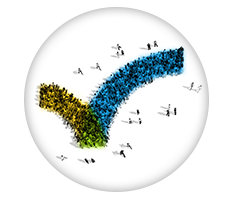The Pros and Cons of B2B Display Advertising

Before you high dive off the B2B Display Advertising springboard into the deep end of the digital marketing unknown you might need to score its pros and cons. What is B2B programmable display or programmatic marketing that’s touted to be the future of advertising on the web?
What is B2B Display Advertising?
It’s essentially an auction for prime advertising space. However, the bidding is automated and happens in a mere millisecond in the space between loading pages. The clever algorithm provides the opportunity to show an ad to a specific customer in a specific context in real time.
Publishers have advertising space on their web page that can be configured for programmatic advertising. When someone clicks on the web page the bidding war starts for that sought after advertising real estate. The ad marketplace runs the bidding process among interested parties and the highest bidder wins the ad space. The maximum price each bidder is prepared to pay for the impression has already been programmed in so the choice is made in just one page-loading click. Although we have seen this functionality with B2C for a while, it’s a new territory that’s opening for B2B due to the availability of behavioral signaling.
In a recent report by Forrester it was stated that programmatic marketing will top the digital advertising spend for the coming year. The Magna Global Programmatic Intelligence report forecasts that by 2019 programmatic display advertising will account for 50% of all advertising. Are you ready to jump on the bandwagon or do you have a few reservations?
The Naysayers
These folks say the limits of B2B program display include:
- Only 8% of online users click on an ad in any given month
- A typical internet user sees 1,707 banner ads a month but the average click-through rate is only 1%
- 8% of users account for 85% of the clicks
- Most “clickers” are under 18 and over 50 with an annual income of less than $30,000
- Its extremely difficult to prove ROI
- The margins seem unimpressive
- You are 31.25 times more likely to win a prize in the Mega Millions than you are to click on a banner ad. (Business Insider)
- You are 87.8 times more likely to apply to Harvard and get in...112.50 times more likely to sign up for and complete NAVY SEAL training...279.64 times more likely to climb Mount Everest...and 475.28 times more likely to survive a plane crash than you are to click on a banner ad. (Business Insider)
The Bell Ringers
These enthusiasts are optimistic about the B2B program display future because:
- Always within your budget - you set the maximum displays
- Extremely targeted and flexible
- Offers opportunities that would not be possible if ad placement had to be done manually.
- You can have the advantage of digital media without having to pre-negotiate a price
- You only pay for the relevant impression that is actually received
- You can sign up for either a minimum number of impressions or a minimum budget
- You can buy digital media across publishers with greatly reduced administration costs.
- People can be targeted to a much greater extent than in the past.
- With the help of big data, you can identify what resonates with each person and target them specifically on the sites that they most frequent at the time they are most likely to engage.
So Why the Big Disparity Between the Two Camps?
At first glance the cons can seem pretty convincing but they do reflect a basic lack of knowledge about the way B2B programmable displays actually work. Let’s bust some myths:
- Success should be seen in a single campaign.
The B2B buying cycle is long so why would a short, sharp, shock consumer ad campaign model be used? Your B2B prospects aren’t buying a pair of sneakers or a weekend away - they need to be nurtured over a longer period of time. Real results will only be seen when you run a campaign over an extended period.
- Display advertising only builds brand awareness.
This thinking means marketers are treating advertising as an afterthought. Ads aren’t produced with strategic focus and so they remain last on the agenda and become self fulfilling prophecies of adding no value. When an ad campaign online is part of an integrated marketing campaign it will drive both awareness and sales conversions.
- No clicks, so no go.
We need new metrics for this new technology. The default metric of click-through rate (CTR) isn’t enough to measure the actual effectiveness of the ads impact.
- You came to visit, so you must like me?
Someone who visits your website could be there for a range of reasons. They are students doing research, a fierce competitor checking out your offering, a job seeker and so on. You do not want to target or retarget all of your visitors. You only want to connect with accounts that demonstrate a number of buying signals.
A Little Patience
Your B2B programmable display advertising becomes powerful when it is backed up by intent signals generated by ABI (account-based intelligence) using near real-time analytics. You will build stronger relationships with your customers using ABM of which display advertising is one of the resource tools. The essential key component of a programmable display campaign is patience. Also A/B test regularly and re-target to ensure success. You can now easily pike, tuck or free dive off any digital springboard into the welcoming waters of display advertising.

